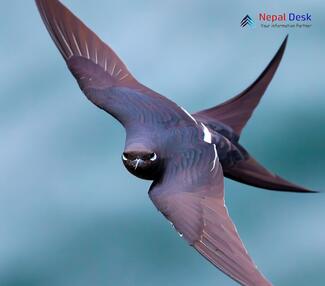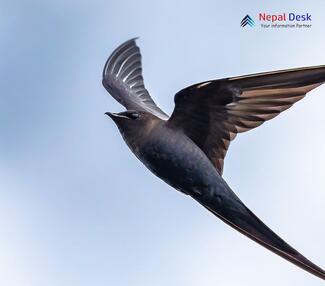The Pacific Swift (Apus pacificus) is an extraordinary bird species that grace the skies with its unparalleled speed and agility. With a vast range stretching from Siberia to Australia, these birds are no strangers to traversing great distances. But what about their presence in Nepal? Let's uncover the details of this fascinating avian species and explore their connection with this beautiful Himalayan nation.
Pacific Swifts: A Brief Overview
Pacific Swifts, also commonly referred to as Fork-tailed Swifts, are medium-sized birds known for their elegant forked tails and strong, rapid flight. Their plumage is mostly dark, with subtle variations in color across their bodies. A key identifying feature is a white throat patch, which stands out against their darker head and neck feathers.
Typically, Pacific Swifts breed in regions across Eastern Asia, such as Siberia, Mongolia, and northern China. Migrating southwards during the colder months, they establish temporary homes in Southeast Asia, Australia, New Zealand, and some Pacific Islands. Their seasonal movements highlight the incredible endurance and navigational capabilities inherent in this species.
The Connection to Nepal
Though it may seem unexpected at first glance, Nepal's diverse landscape makes it a perfect stopover for many migratory bird species—including the Pacific Swift. During the Northern Hemisphere's winter season, some populations of Pacific Swifts choose the subtropical climate of this South Asian country as their temporary refuge.
Nepal boasts a wide array of ecosystems, varying from dense forests to wetlands that provide ample food sources and nesting locations for winged visitors. As the country witnesses more than 890 bird species—the Pacific Swift being one mere example—it comes as no surprise that Nepal has become a favored destination among birdwatchers and nature enthusiasts alike.
Protected Areas and Conservation Efforts
Recognizing the importance of preserving precious habitats for indigenous and migratory bird populations, Nepal has established numerous protected areas. These designated zones enable the Pacific Swift and other visitors to continue their migratory journeys unhindered. The Chitwan National Park, Sagarmatha National Park, Koshi-Tappu Wildlife Reserve, and Bardia National Park are just a few examples of Nepal's commitment to maintaining vibrant ecosystems for all living creatures.
In addition to national efforts, several non-governmental organizations work tirelessly in Nepal to safeguard these essential habitats. Collaborating with local communities and international institutions, these organizations execute comprehensive strategies for bird conservation and ecosystem preservation throughout the country.
Closing Thoughts
The magnificent Pacific Swift provides an exciting glimpse into the avian diversity present in Nepal. As it traverses several thousand kilometers in its annual migration, this resilient species exemplifies the awe-inspiring feats that many birds are capable of achieving. Through concerted conservation initiatives and a continued appreciation for our feathered friends, we can hope that future generations will experience the fluttering joy of watching Pacific Swifts grace the skies above Nepal.




